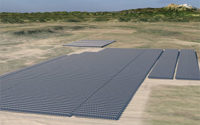By 2016, a solar satellite could begin beaming up to 4,000 MW a year via microwave to a receiving station in Fresno, Calif., now that Solaren Corp. has signed a 200-MW power sales contract with Pacific Gas & Electric Co.
Solaren, Manhattan Beach, Calif., is still designing the system, but plans call for an array of geosynchronous orbiting mirrors several miles wide to focus sunlight onto photovoltaic cells. An amplifier will convert the electrical power into a microwave beam aimed at a ground receiving station in Fresno County, where it will be converted to AC power and fed into the PG&E grid.
“The receiver is like a mile-and-a-half-dia carpet with millions of antennas that resonate at a set frequency,” says James E. Rogers, Solaren’s chief scientist.
“We support a diverse array of technologies to reach our renewable goals,” says Jonathan Marshall, a spokesman with San Francisco, Calif.-based PG&E. The utility is not taking any risks, Marshall stresses. It will only pay for power delivered. But the price is “in line with prices for other renewables,” he says. The California Energy Commission puts the cost of solar energy as high as $0.696 per kilowatt-hour.
Solaren is raising billions of dollars for the project and plans to grow from 10 employees to more than 100 in the next year, according to Rogers. Actual construction could begin in 2013.
Solaren isn’t alone in trying to bring to life the technology proposed in Isaac Asimov’s 1941 science fiction novel “Reason.” Switzerland-based Space Energy Inc. has plans to launch a low-earth-orbit demonstration satellite that would generate power.


Post a comment to this article
Report Abusive Comment